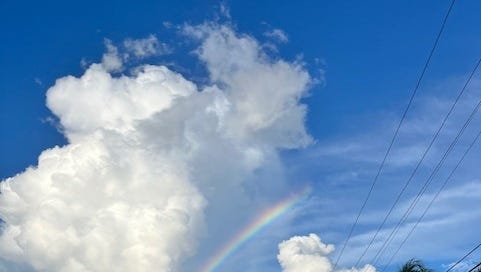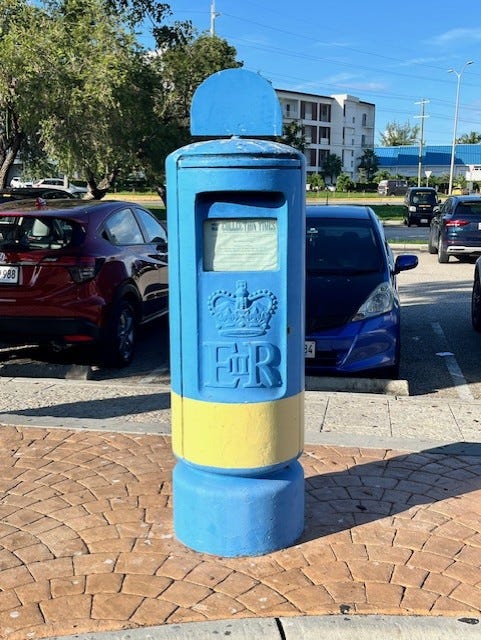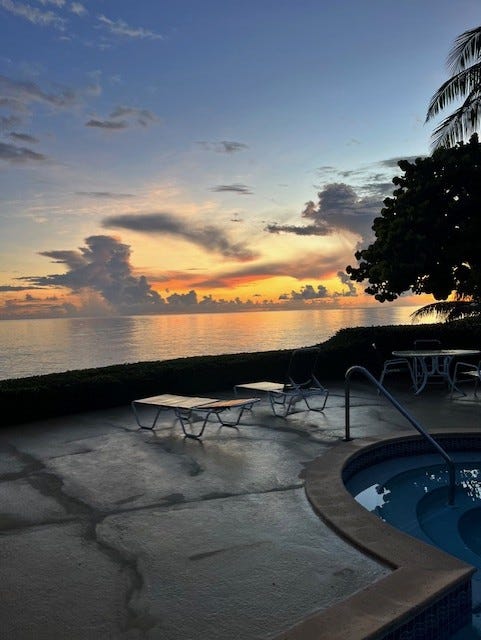I’ve been in the Caribbean for almost two weeks. It takes time to build up friendships and a routine to life in a new place, and when everything is new, the body and mind are no longer on autopilot so they have to work hard to process everything. Two of my primary needs have been getting good sleep, and navigating the traffic to work, which started on Monday. The two mile journey has taken between 12 minutes and 45. On the busiest days I’ve watched people walking past the car, and wished I could get out and join them. As a keen walker, not being able to walk any kind of distance above a couple of hundred meters in the day is one of the things I’m finding hardest to adjust to. It’s just too hot after 7am.
So I’m learning the different routes into work, and the best times to leave. In five days I have taken three different routes to work, and three routes home, five different routes in total. The ‘best route’ depends on the precise time of day that I leave. Because my current home is temporary, I’ve got two weeks to find my next place to live. It’s been great looking around at different options, but also difficult to know where to choose. Traffic times have been a big point of discussion. The agent who showed me round properties last weekend had lots of helpful advice. If I want to reduce the sit in traffic time, apparently I need to move to the top side of the island, as there are more roads for slightly fewer people. It’s an excuse to explore, although the clock is ticking...
Have I really only been here for 12 days?
Time is a such a funny thing. Part of me feels like I’ve been here for ages, and another is still not quite sure where I am. My body exemplifies this by seeming to be stuck between the two time zones of the UK and the Cayman Islands. I’m waking up somewhere between 4 and 6 am, and wanting to go to bed around 9pm. I try to have a little read in the evening, and generally wake up with the lights on, book fallen open to my side. But the early mornings were welcome. At the beginning of the week I snuck out for a walk, or a swim before work. It felt like such a treat to go to the sea before getting in the shower, and I appreciated the chance to move my body. By the end of the week, I stayed in bed, trying to get back to sleep, but this morning I was up early, and caught this amazing view- my first Cayman rainbow.
Picture of a rainbow swooping up from the sea, through the clouds. Thanks go to the lady who paused her run to take a photo. I was driving with this view to my back, so wouldn’t have noticed it if she hadn’t so obviously stopped at the side of the road. The colours were more vibrant in real life, but I couldn’t see much as the humidity immediately fogged up my glasses when I got out of the car! This fogging has not happened before- I think rain is due today.
The beginners mind
Buddhism, meditation, and mindfulness practices often refer to a state of being called ‘the beginners mind’. This encourages us to approach situations as if everything is new, so that we see things with curiosity, wonder, and an open mind. If we can let go of the idea of ‘what should happen’, or how ‘we want things to be’, it said to be easier to accept, and to be present to what is, and to learn rather than resist and experience suffering. It is also known as Shoshin.
One of the joys of travelling to new places is the feeling of wonder that we can get when we experience something new. For example, this morning I went to the supermarket, and I saw a post box for the first time. Houses here are often painted in a range of soothing pastels, and maybe all the post boxes are too?
At Hurley’s supermarket. I’ve been to this supermarket twice, and the first time my attention was drawn by the chickens beside my car. This time, I noticed this beautiful blue and yellow post box. It’s familiar enough to be recognisable, but different enough to spark wonder and curiosity. There must be a function to the fan like hat at the top? Beginners mind curiosity. Any guesses?
The postal system is another thing that I remain unclear how it works. My understanding is that there is a different postal system here in the Cayman Islands, and rather than having letter boxes, residents have personal postal boxes and go to collect things from the post office (when I hear the word post office box my brain automatically shoots me back to Sarah Greene, Simon Groom and Peter Duncan reading out the mysterious Blue Peter address of PO Box… London). I don’t yet have one, marking me out as a newbie with my blank boxes on my applications for a bank account and health insurance!
Tolerating uncertainty
Christian Jarrett, cognitive neuroscientist, writes about the beginners mind in his online article here. He acknowledges the cultural challenges that might make it difficult to adopt a beginners mind, particularly as we can sometimes find it threatening to our ego and sense of self to admit when we do not know something. It puts me in mind of a model, or concept, taught in my systemic training many years ago, Barry Mason’s positions of certainty and uncertainty in therapeutic practice. In this paper, Mason explains how scientists such as Heisenberg (German physicist, known for quantum mechanics) acknowledged that there is a limit to how much we can know and that uncertainty is the predominant aspect of living in the world. He explains that this does not mean we construct reality, but that we construct our relationship to it. This reminds me of the literary criticism module in my English Literature degree about postmodernism, and exploring Lyotard’s (1984) suggestion of things in the world being unrepresentable, and reading a book that gradually deconstructed everything that we might understand to be real in a novel… Mind blown!!
Extract from my English lit presentation handouts in one of the most interesting but challenging modules I took!
Fortunately Mason does not take us into the mind bending position of there being no objective reality, but he does acknowledge that my representation of reality will not necessarily correspond with yours, and that the position of certainty we find ourselves in, shifts.
Diagram to show Mason’s positions of safety and uncertainty
I find these principles a helpful way to think about our experience of significant life changes, as it normalises the terror and calm that can come in different contexts. How the ground that we were standing on suddenly changes. We feel wobbly, and uncertain. At times this can feel safe, and at other times, we can feel unsafe. Having an awareness of where we are, and what we need, is particularly important in therapeutic work.
First order perspective-
Clients tells us the problem - Diagnose the problem - Lead them back to health
Mason reflects on a shift in family therapy approaches from this position of certainty to one of ‘fit’-
Explore problem WITH clients - Hypothesise- Explore meaning & new solutions
He proposes a term called ‘authoritative doubt’, where therapists retain expertise, but have an openness to multiple alternative perspectives. For instance, it might be helpful for one family to use a diagnostic frame of reference to make sense of difficulties experienced by a child, but for another, it might not. The therapist’s goal is to consider what type of meaning is helpful for a particular client, and what possible solutions come out of this.
The therapist’s position is not fixed, nor certain, but is confident. This is what is meant by safe uncertainty. It is like being in the sea, and having an anchor.
Unsafe uncertainty is losing anchor, and being subject to the storms.
Navigating times of unsafe uncertainty
All of us, if we allow ourselves to experience uncertainty and change, will find ourselves in a merry dance between Mason’s four positions. The post box makes me feel uncertain, but safe, so I can enjoy the state of curiosity. Learning the new office recording system, does not! I feel pressure to feel more certain of what I’m doing, as a level of functioning is required to accompany the therapeutic aspects of my job. I find it hard to bring a curious, beginners mind to these types of learning situations!
It’s important to remind ourselves that these experiences are normal. Of course we don’t know yet, and hopefully people don’t yet expect us to. How others respond to uncertainty in themselves and others inevitably influences our experience of this sea dance. Finding people to help, and feeling safe and supported helps us to navigate the waves between safe and unsafe uncertainty. It helps to makes the moments of seasickness tolerable!
As with so many things, the important word is balance, and how we find it. Accessing beauty in nature, and swimming, are the most easily accessible anchor points I have from my apartment. For this reason, most evenings I’ve gone outside, looked at the horizon, listened to the sound of the waves, and taken a short swim. I’ve used mindfulness to notice the feel of my fingers in the water, and the sensation of my body being held in its buoyancy. Yesterday I popped my head up to find a surprised kitten amongst the grass. We stared at each other, and although I couldn’t persuade it to come closer, we had a brief game of peekaboo. I enjoyed watching the kitten’s intent curiosity about me, ears twitching with each of my movements. We responded to each other. The kitten ran off when I resumed my swim, pausing for a look from a further, and safer distance, before deciding the uncertainty was too unsafe, and running from view.
In these moments I am back to full anchor. Certain that I am safe, and enjoying a connection with something real in the world. I relish the things that connect me in this way, bring me wonder, and help me drop anchor. It means I can enjoy the waves of novelty and joy, and it becomes easier each time I am untethered, to return to safety.
I don’t have a photo of the kitten, but this was the view of the sea as I got in for my swim. The sky was not quite so dark, with a pink hue along with the yellow. A fishing boat passed by, silhouetted against the colours as the fishermen went about their work.
It can take time for storms to settle. Wonder, and joy help each of us to anchor in the storms. With safety come an open mind and open heart.
What are the things that anchor you?









Such a lovely post, Jo! I've just started a new job and I'm navigating the waves of certainty and uncertainty, both safe and unsafe! :D I've never heard of Mason's model but will definitely use it as a framework for this new beginning for me. Thank you!
Your photos look beautiful, continue enjoying your mindfulness moments in nature! And I hope you see the kitten again. :)
Lovely post Jo. I like that model (which is new to me) and shall carry that idea of safe and unsafe uncertainty with me. Also lovely to get a peek into your adventures. I hope the new job is going well so far 😀